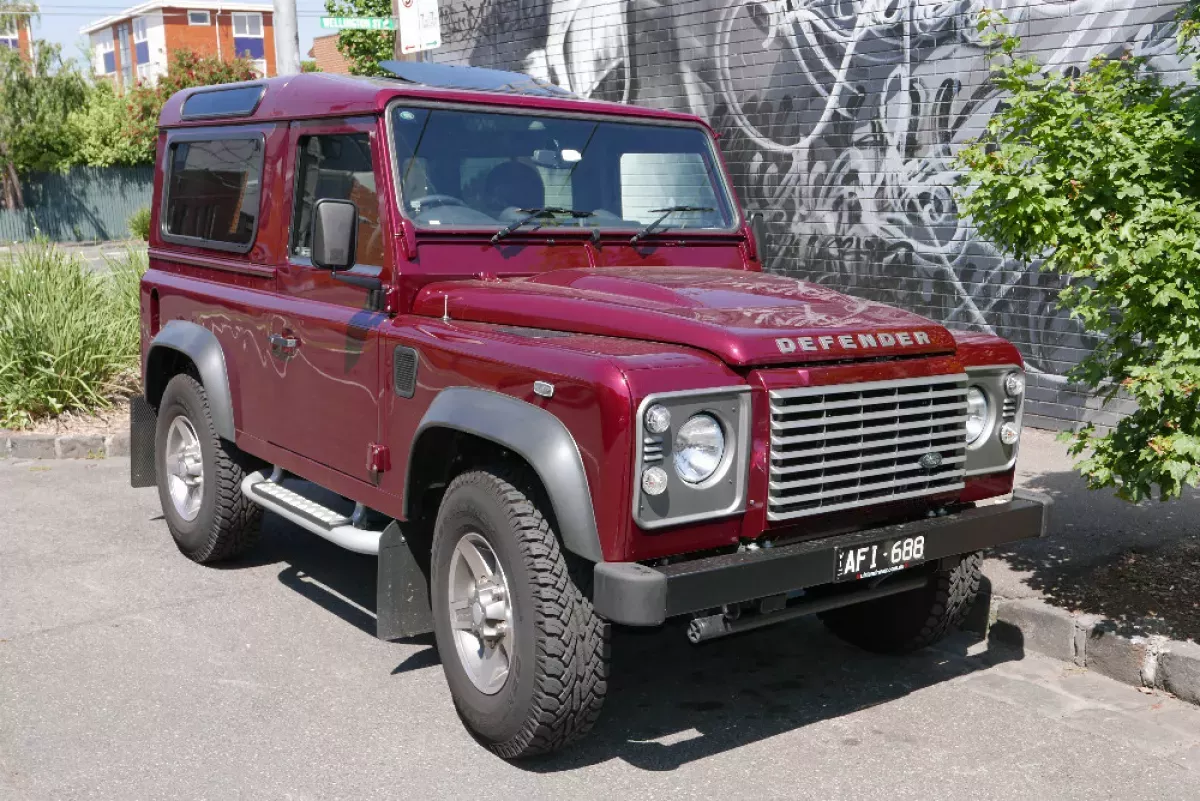The Land Rover Defender, a series of British off-road vehicles, originated from the 1948 Land Rover. Initially, "Land Rover" referred to a specific model, but the introduction of the Land Rover Discovery in 1989 broadened "Land Rover" into a marque. Consequently, the existing models (90, 110, and 127) were rebranded as Defender 90, Defender 110, and Defender 130, respectively, in 1990. These vehicles are renowned for their consistent four-wheel drive capability.
April 1948: Amsterdam Motor Show Introduces the Original Land Rover
The Land Rover made its debut at the Amsterdam Motor Show in April 1948, marking the beginning of the iconic off-road vehicle's journey.
1948: Launch of the Land Rover Series I
This year marked the debut of the original Land Rover Series I, a vehicle that laid the groundwork for the Defender lineage.
1949: Part-Time 4WD System: A Brief Appearance
Land Rover initially offered the Defender with a part-time 4WD system, a familiar feature from derivatives produced since 1949. However, due to poor sales, this option was quickly removed from the options list.
1958: Santana Begins Licensed Production
Santana Motors in Spain began producing Land Rover vehicles under license in 1958.
1959: Land Rover Use in Australian Military
Land Rover vehicles have been utilized by the Australian military since 1959.
1971: Series III Dashboard Layout Introduced
Land Rover introduced a dashboard layout in their Series III model in 1971, which was later carried over to the Defender 110 in 1983.
1974: Last Year of Utility Land Rovers in North America
Before the Defender's arrival in 1993, the last time utility Land Rovers were available in North America was 1974.
1980: Land Rover Experiences Sales Decline
Land Rover faced a significant sales decline in the 1980s, with a substantial 21% drop in sales between 1980 and 1981, attributed in part to the poor reputation of British Leyland, its parent company at the time, for substandard build quality and unreliability.
1981: Land Rover Implements Modernization and Streamlining Measures
Following a sales decline, Land Rover undertook a series of modernization and streamlining initiatives. The company implemented marketing strategies to attract new customer demographics, consolidated production to its Solihull factory (which was expanded), and shut down several satellite factories in the West Midlands that previously produced Land Rover parts. These measures aimed to improve efficiency and market presence.
1981: Isuzu Engine in Australian Defenders
From 1981, the Isuzu 4BD1 engine became the sole diesel option for Land Rover vehicles in Australia.
1981: Land Rover Upgrades 2.25L Engines for Enhanced Performance
In 1981, Land Rover implemented a significant upgrade to its 2.25-liter engines. The upgrade involved increasing the crankshaft bearings from three to five, a strategic move aimed at accommodating future increases in engine capacity and power. This five-bearing variant, though mechanically different, retained the 2.3-liter designation.
1983: Defender's Design: A Blend of Familiar and New
Despite the numerous updates in 1983, the post-1983 Defender retained a visual resemblance to the Series III Land Rover, showcasing a blend of familiar design cues and new features.
1983: Land Rover Introduces the 127-Inch Wheelbase Model
In 1983, Land Rover added a third wheelbase option to its utility lineup. Designed to handle larger loads, the 127-inch wheelbase model, known as the "Land Rover 127," was specifically engineered for utility companies and military applications. This four-door, six-seater vehicle combined the front of a 110 4x4 with the rear of a 110 high-capacity pickup, enabling simultaneous transport of work crews and equipment.
1983: Last Major Update Before 2020
Prior to the unveiling of the 2020 Defender, the last time the vehicle received a complete overhaul was in 1983, making the 2020 release significant.
1983: Production of the Defender Begins with Land Rover 110
Production of the vehicle now recognized as the Defender commenced in 1983 with the introduction of the Land Rover 110. The "110" in its name represented the vehicle's 110-inch (2,800 mm) wheelbase.
1983: Santana's Land Rover License Expires
Santana Motors' license to build Land Rovers expired in 1983.
1983: Land Rover 110 Debuts with Familiar Engine Options
The 1983 Land Rover 110 debuted with a familiar engine lineup, inheriting the 2.25-liter petrol and diesel engines and the 3.5-liter V8 petrol unit from the Series III vehicles it replaced. A limited production run of 3.2-liter V8 engines was also produced.
1983: Land Rover 110 Launches, Followed by the 90
The Land Rover 110 was launched in 1983, with the 90 following shortly after in 1984.
1983: Original Defender 110 Dashboard Design
The original Land Rover Defender 110, launched in 1983, featured a dashboard layout similar to the Series III from 1971.
1983: Introduction of the Coil-Sprung Land Rover One Ten
The year 1983 witnessed the introduction of the coil-sprung Land Rover, named the "Land Rover One Ten," signifying a shift in suspension technology.
1984: Santana Introduces Land Rover Derivatives
Following the expiration of their licensing agreement, Santana introduced its own derivatives of Land Rover models in 1984.
1984: Land Rover 90 / Ninety Joins the Lineup
In 1984, Land Rover expanded its lineup by introducing the Land Rover 90 / Ninety model, complementing the existing Land Rover 110 / One Ten.
1984: Wind-Up Windows and New Diesel Engine Introduced
In 1984, wind-up windows became a standard feature, replacing the sliding panels found on earlier models and the very first 110s. Additionally, a new 2.5-liter (153 cu in) diesel engine, based on the earlier 2.3-liter engine but with fuel injection and increased capacity, was introduced, offering improved efficiency and performance.
1984: Land Rover Ninety Joins the Lineup, Expanding Choices
Land Rover introduced the "Land Rover Ninety" in 1984, adding a shorter wheelbase option to the range and further diversifying the lineup.
1984: Design Evolution and Engineering Refinements
The Land Rover underwent significant design changes in 1984, including a full-length bonnet, integrated grille and headlights, and a single-piece windscreen. A part-time 4WD system was introduced but later dropped due to poor sales. A new series of modern, more powerful engines were gradually incorporated.
1984: Defender Embraces Modernization While Retaining Core Elements
While retaining certain elements from the Series III, such as the engine and some body panels, the Defender 90 and 110 underwent significant modernization in 1984.
1985: Land Rover Introduces Upgraded Petrol Engines and Expands V8 Availability
1985 marked a significant year for Land Rover's petrol engine lineup. An enlarged four-cylinder, 83 hp, 2.5-liter engine was launched, sharing its block, cooling system, and other ancillary components with the diesel variant. Unlike the diesel, this new petrol engine retained the chain-driven camshaft from its 2.25-liter predecessor. Simultaneously, the powerful 114 hp V8 engine was made available in the 90 model, marking the first time a production short-wheelbase Land Rover received V8 power. Both models featuring the V8 engine were equipped with the all-new five-speed LT85 manual gearbox.
1985: British Army Adopts Land Rover One Ten
In 1985, the British Army replaced its Series III fleet with the Land Rover One Ten, marking a significant shift in their military vehicle lineup.
1985: Land Rover 127 Introduced with Numerical Naming
The Land Rover 127, featuring a 127-inch (3,226 mm) wheelbase, was introduced in 1985, always marketed with its numerical designation.
1985: Land Rover 127 Extends the Wheelbase
The year 1985 saw the addition of the Land Rover 127 to the lineup, offering an extra-length option to customers.
1986: Land Rover Ninety Introduced to British Army
Following the introduction of the One Ten, the British Army added a smaller fleet of Land Rover Nineties in 1986, further solidifying Land Rover's presence in their fleet.
1986: Land Rover Introduces "Diesel Turbo" Engine
In September 1986, Land Rover introduced the "Diesel Turbo" engine, a turbocharged version of the existing 2.5-liter diesel engine, designed to enhance performance and compete with offerings from Japanese automakers. This engine incorporated a redesigned crankshaft, Teflon-coated pistons, nimonic steel exhaust valves, an eight-bladed cooling fan, and an oil cooler to handle the increased power output and internal temperatures.
1987: Land Rover Establishes Special Vehicles Division
In 1987, aiming to increase European sales, Land Rover created the Special Vehicles Division. This division focused on conversions, adaptations, and limited-run versions of its vehicles. A significant portion of the division's work involved building stretched-wheelbase mobile workshops and crew carriers for utility companies in Britain and Europe.
1987: Range Rover Sales Begin in North America
The Range Rover entered the North American market in 1987, predating the Defender's introduction to the region.
1987: Otokar Begins Defender Production
Turkish automaker Otokar commenced production of Defenders and their derivatives in 1987.
1988: Land Rover Addresses Reliability Issues in Turbo Diesel Engine
In 1988, Land Rover introduced a revised block and improved big end bearings for the Turbo Diesel engine to address reliability concerns.
1989: Land Rover Implements Redesigned Breather System for Turbo Diesel Engine
Land Rover introduced a redesigned breather system for the Turbo Diesel engine in 1989, further enhancing its reliability and longevity.
1989: Land Rover Launches Discovery with New Turbodiesel Engine
Land Rover launched the Discovery model in 1989, featuring a new turbodiesel engine called the 200TDi. This engine, while based on the existing 2.5-liter turbo unit and built on the same production line, boasted several advancements, including a modern alloy cylinder head, enhanced turbocharging, intercooling, and direct injection.
1989: Land Rover Discovery Sparks Naming Conventions
The introduction of the Land Rover Discovery in 1989 led to a shift in naming conventions for existing models to avoid confusion.
1989: Land Rover Discovery Ushers in a New Era
With the introduction of the Land Rover Discovery in 1989, the "Land Rover" name transitioned into a broader marque, encompassing a wider range of vehicles.
1990: Engine Upgrades Enhance the Land Rover 127
By 1990, the Land Rover 127 saw significant engine improvements. It was offered exclusively with the two most powerful engine options: the 134 hp, 3.5-liter V8 petrol engine, and the 85 hp, 2.5-liter turbo diesel engine, enhancing its performance and towing capabilities.
1990: Land Rover Showcases Amphibious Land Rover 90 at Cowes Week
From 1987 to 1990, Land Rover sponsored Cowes Week and used the event to showcase an amphibious Land Rover 90 created by its Special Vehicles Division, highlighting the brand's commitment to innovation and versatility.
1990: Transformation to Defender 90 and Defender 110
In 1990, the Land Rover 90 and 110 underwent a name change, becoming the Defender 90 and Defender 110, respectively.
1990: Land Rover 90 and 110 Rebranded as Defender
In late 1990, the Land Rover 90 and 110 underwent a significant rebranding, becoming the Land Rover Defender. This change was prompted by the introduction of the Discovery model in 1989, necessitating a distinct name for the original Land Rover.
1990: End of Isuzu Engine Exclusivity in Australia
The Isuzu 4BD1 engine, which was the only diesel choice for Land Rover in Australia since 1981, ceased to be the exclusive option.
1991: Ninety and One Ten Rebranded as Defender 90 and Defender 110
In 1991, the Ninety and One Ten were renamed "Defender 90" and "Defender 110" respectively, solidifying the "Defender" name within the Land Rover brand.
1991: Italian Army Adopts Defender 90
The Italian Army adopted the Defender 90, designated as "AR 90" (Reconnaissance Vehicle), in 1991. They favored the soft-top version, equipped with various engine options including the 2.0 petrol, 2.5 diesel Td5, and 2.4 diesel Td4.
1992: Land Rover Launches Limited-Edition SV90
In 1992, Land Rover released the SV90, a limited-edition model that included features like a roll-over protection cage, alloy wheels, and metallic paint.
1992: First Special Edition Defender Released
Land Rover produced its first special edition Defender, the 90SV, in 1992. This limited-run model featured distinctive styling elements and was produced by the Special Vehicle Operations department.
1992: Last production year of the soft-top Defender in the UK (before the SVX)
The year 1992 marked the end of the soft-top Defender's availability in UK showrooms, a model type that would later be revived with the 2008 SVX edition.
1993: Defender Launched in North America
Land Rover introduced the Defender to the North American market in 1993. This marked the return of utility Land Rovers to the region since 1974.
1993: North American Specification (NAS) Defender 110 Features Unique Badging
The North American Specification (NAS) Defender 110, sold for the 1993 model year, featured a "Defender" badge above the radiator grille, setting it apart from other models.
1994: Defender 90 Offered in North America
For the 1994 model year, Land Rover introduced the Defender 90 to the North American market, positioning it as a competitor to the Jeep Wrangler.
1994: Land Rover Introduces 300Tdi Engine
In 1994, Land Rover introduced the 300Tdi engine, a significant evolution of the Tdi engine series. While the 200Tdi had represented a substantial leap forward, the 300Tdi was a nearly completely new design, despite having the same capacity. Both the Defender and Discovery models were equipped with this engine, boasting an output of 111 bhp and 195 lb-ft of torque.
1994: Land Rover Defender XD Debuts
Land Rover launched the Defender XD (extra duty) in 1994 to enhance the durability and load capacity of their military vehicles. The XD featured a reinforced chassis and was available in both 90 and 110 forms, known as the Land Rover Wolf by the British Army.
1994: End of Santana Series IV Production
Production of the Santana Series IV, a derivative of the Land Rover, concluded in 1994.
1994: NAS Defender 90 Debuts with Distinct Grille Decals
The NAS Defender 90, sold between 1994 and 1997, featured "Land Rover" spelled out in individual letter decals across the top of the radiator grille, differentiating it from other Defender models.
1995: Defender 90 Body Style Options Expand
Building on the 1994 introduction, Land Rover expanded the Defender 90's body style options in 1995, offering a removable fiberglass roof panel or a traditional hardtop.
1995: Defender 90 2.8i Prototype Created
In 1995, Land Rover engineers in South Africa created the first Defender 90 2.8i prototype by modifying a North American specification 1995 Defender 90 soft-top model, nicknamed "Green Mamba".
February 1996: Development of the Defender 2.8i Begins
In February 1996, Land Rover and BMW collaborated to develop the Defender 2.8i. This project involved converting existing V8 Defenders to house the BMW M52 engine.
1997: Defender Fails to Meet US Safety Standards
By 1997, the Defender no longer met US safety requirements, leading Land Rover to offer US buyers alternatives like the LR2 (Freelander) and LR4 (Discovery).
1997: Launch of the Defender 2.8i
In 1997, Land Rover South Africa introduced the Defender 2.8i, a unique model powered by a BMW petrol engine. This model was offered in both 90 and 110 variants and was produced until 2001.
1997: Land Rover Defender 90 Limited Edition
In 1997, Land Rover released 300 special edition Defender 90s called the Limited Edition (LE). They came in a unique Willow Green color with a white roof, and features like body protection, air conditioning, and a numbered placard.
1997: Final Year of US Defender 90 Production and Engine Upgrade
In 1997, the last year of Defender 90 production for the US market, the vehicle received an engine upgrade, moving to a 4.0-liter engine paired with a four-speed automatic transmission.
1997: Safety Regulations Halt Defender Sales in North America
Land Rover was forced to discontinue Defender sales in North America in 1997 as the vehicle no longer met the required safety standards, leading to a hiatus in the market.
1997: NAS Defenders Receive Limited Edition Plaques
NAS Defenders were adorned with a cast plaque on the rear tub, a design reminiscent of the Series estate cars. The plaque displayed "Defender 110" or "Defender 90" beneath the Land Rover lozenge, along with a unique production run number reflecting its limited edition status.
1998: 300Tdi Engine Introduced for Military Defenders
Land Rover began utilizing the 300Tdi engine in their military Defender fleet in 1998, prioritizing its robustness and simplicity for battlefield conditions.
1998: Land Rover Celebrates 50th Anniversary with Special Edition Defender
Land Rover celebrated its 50th anniversary in 1998 with a special edition Defender 90. This commemorative model came equipped with features such as automatic transmission, air conditioning, and Range Rover's 4.0-liter V8 engine.
1998: New Safety Regulations Challenge Defender
New safety regulations in 1998, mandating airbags and side door impact standards, posed difficulties for the Defender's design. The required modifications were deemed too costly given the vehicle's limited sales.
1998: Land Rover Defender Heritage Edition
The "Heritage" edition, launched in 1998, celebrated Land Rover's origins. Available in 90 or 110 variants and the original colors of bronze green and pastel Atlantic green, it aimed to resemble the 1948 Series I. Features included a mesh grille, body-colored accents, and unique interior instruments.
1998: Introduction of the Td5 Engine
The Defender received a new engine in 1998, the 2.5-liter, five-cylinder turbodiesel Td5, replacing the Tdi to meet Euro III emissions regulations.
1998: Land Rover Defender 50th Anniversary Edition
To celebrate their 50th anniversary in 1998, Land Rover released the Defender 50th Anniversary Edition, a NAS Defender 90 with a 190 hp 4.0-liter V8 engine and automatic transmission. Notable features included Atlantis blue paint and a Safety Devices roll-over protection cage.
1999: BMW Creates Wiring Diagrams for Defender 2.8i
BMW South Africa created wiring diagrams for the Defender 2.8i, categorized as Pre MY99 (for 1999 and older models) and MY99 (for 2000 and newer models).
1999: Karmann Starts Defender Production in Brazil
Karmann initiated Defender production in Brazil using CKD kits from Land Rover in 1999.
1999: Land Rover Defender X-Tech (First Edition)
Targeting the commercial market in 1999, the metallic silver Defender 90 X-Tech had features like County-style seats and alloy wheels.
2000: New Wiring Diagrams for Defender 2.8i
BMW South Africa introduces updated wiring diagrams categorized as MY99 for the 2000 and newer Defender 2.8i models.
2000: British MOD Adopts TD5 Land Rover Defenders
Breaking from their initial stance, the British MOD procured a fleet of TD5 Land Rover Defender 110s between 2000 and 2002, recognizing the engine's suitability for demanding terrains like the Falklands.
2000: Land Rover Defender "Tomb Raider" Edition
In 2000, Land Rover introduced the "Tomb Raider" edition, inspired by the film. Designed to look like an expedition vehicle, it featured dark metallic grey paint, a roof rack, extra lighting, a winch, a bull-bar, and a raised air intake.
2000: Major Updates for the Defender 2.8i
The Defender 2.8i received significant updates for the 2000 model year, including new instrumentation, an updated chassis, improved electrical systems, and a redesigned cooling system.
2001: End of Production for Defender 2.8i
Production of the Defender 2.8i, a South African special edition with a BMW engine, ended in 2001 after a four-year run.
2002: TD5 Land Rover Defenders Join British Forces
After successful trials by the Australian Defence Force, the British MOD integrated TD5 Land Rover Defenders into their "Green Fleet" between 2000 and 2002. These vehicles, specially adapted for military use, served primarily in the Falklands.
2002: Defender Receives Refinements and New Features
In 2002, the Defender's Td5 engine was refined for emissions, the "XS" trim was introduced, and several detail improvements were made, including a new center console, improved instrument lighting, and the introduction of front electric windows.
2002: Land Rover Defender Black Limited Edition
The 2002 Defender Black Limited Edition, available in 90 Station Wagon and 110 Double Cab Pickup, came with Java black metallic paint, added safety features, chequerplate protection, and unique interior trim with black leather and billet aluminium accents.
2003: Land Rover Defender G4 Edition
Following the first Land Rover G4 Challenge in 2003, the G4 Edition was released in Tangiers orange, yellow, silver, and black, featuring upgrades like a front A-bar, roll-cage, side-steps, and front spotlights.
2003: Land Rover Defender X-Tech (Second Edition)
The second edition of the X-Tech was launched in 2003 with enhancements like wing protector plates and air conditioning.
2004: German Government Orders Td5 Land Rovers
The German government commissioned a fleet of 12 long-wheelbase 110 Td5 Land Rovers in 2004, showcasing a diverse range of configurations including vans, HCPUs (Hard Covered Pick Ups), and traditional 4x4s.
2006: German Government Ends Land Rover Contract
After a brief stint with Land Rover, the German government opted not to renew their supply contract in 2006, shifting their focus to Mercedes for their logistical fleet needs.
2006: Military Duratorq Engine Introduced
As production of the 300Tdi engine ceased in 2006, Land Rover transitioned to a military-spec version of the Ford Duratorq engine, aligning their military offerings with the engine used in civilian models.
2006: End of Karmann Defender Production
Karmann ceased production of Defender models in Brazil in 2006.
2007: Defender Seating Layout Changes and New "Utility" Body
Due to EU safety regulations, the 2007 Defender's seating layout was changed, replacing inward-facing rear seats with forward-facing ones. A new "utility" body style was also introduced for the 110, featuring a five-door layout with a secure load space.
2007: Iveco Massif Launch
Fiat, through its Iveco commercial vehicle division, launched the Iveco Massif, a modified Santana PS10, in 2007.
2007: Defender Badge Evolution and Minimalist Branding
From 2007 onward, the Defender adopted a more minimalist branding approach. While retaining the space for the badge above the radiator grille, it remained blank. The "Land Rover" inscription was displayed prominently on the bonnet's leading edge.
2007: Introduction of 2.4-Liter Duratorq Engine
In 2007, Land Rover introduced a 2.4-liter Duratorq engine to the Defender model.
2007: Defender Gets Engine and Gearbox Overhaul
The Defender underwent major changes in 2007, including a new Ford DuraTorq engine and a six-speed gearbox, to meet emissions and safety regulations.
2008: Land Rover Defender SVX Edition
Celebrating Land Rover's 60th anniversary, the black "SVX" Defender came in 110, 90, and a new 90 soft-top, featuring unique graphics, alloy wheels, a redesigned grille, and upgraded interiors with Recaro seats and a Garmin GPS system.
2009: Land Rover Expands Model Range in Australia
In mid-2009, Land Rover expanded its model offerings in Australia to include 110 and 130 cab-chassis, panel van, and HCPU versions.
2010: Re-introduction of the Defender 90 in Australia
Land Rover announced the return of the Defender 90 4x4 model to the Australian market in early 2010.
August 2011: Land Rover Announces Defender Update and New Model Plans
In August 2011, Land Rover announced an update for the Defender for the 2012 model year and publicly acknowledged the development of an all-new replacement model.
2011: Land Rover Unveils DC100 Concepts
Land Rover presented the DC100 and DC100 Sport concept cars at the 2011 Frankfurt Motor Show. These designs hinted at a potential direction for the Defender's future.
2011: Iveco Massif Discontinuation
Production of the Iveco Massif, a derivative of the Santana PS10 marketed by Fiat, ended in 2011.
2012: Engine Update and Reintroduction of Soft Top
In 2012, Defender models received a new Ford Duratorq engine, a 2.2-liter variant with similar power and torque to its predecessor. This marked the first time a Defender included a diesel particulate filter. Additionally, the soft top body style was reintroduced to the general market after being limited to special orders and military buyers.
2012: Defender Update Released
Land Rover released an update for the Defender in 2012, incorporating changes announced the previous year.
2013: Falklands TD5 Defenders Auctioned
In 2013, the majority of the TD5 Defender fleet deployed in the Falklands were sold off by the MOD to Military Motors Ltd, marking the end of their service in that region.
May 2015: Two Millionth Land Rover Defender Auctioned for Charity
In May 2015 a special team assembled the two millionth Land Rover Defender. It was then auctioned to raise funds for the International Federation of Red Cross and Red Crescent Societies.
May 2015: Land Rover Defender by Paul Smith
In May 2015, Land Rover collaborated with designer Paul Smith to create a unique Defender. This one-off edition showcased 27 colors on its exterior, drawing inspiration from the Defender's service history and the British landscape.
2015: New European Safety Regulations Impact Defender
In 2015, new European regulations regarding pedestrian crash safety (Euro NCAP) posed challenges to the Defender's design, contributing to the need for a complete redesign.
2015: New Safety Regulations Challenge Defender Design
Stringent safety regulations, particularly those regarding pedestrian safety and mandatory airbags for commercial vehicles, were set to be implemented in 2015, posing significant challenges to the Defender's existing design.
January 2016: End of an Era: Land Rover Defender Production Concludes
After a remarkable 67-year production run, the final Land Rover Defender rolled off the production line in January 2016. Over two million Land Rover Series and Defender models were manufactured during this period.
January 2016: Last Defender Rolls Off the Production Line
On January 2016, the last Defender, a soft-top "90", was produced at the Solihull production line, marking the end of an era for the iconic vehicle.
2016: Final Defender Model Retains Minimalist Branding
The last Defender model, produced until 2016, continued to feature the minimalist branding approach, with no badges indicating the specific wheelbase model. A new-style "Defender" badge with an underlining "swoosh" adorned the rear.
January 2018: Defender Works V8: A Powerful Farewell
In January 2018, Land Rover announced a special edition Defender Works V8, boasting an impressive 400 bhp (298 kW) engine, as a final tribute to the iconic model.
January 2018: Land Rover Defender Works V8
Land Rover unveiled the Defender Works V8 in January 2018 as a "restomod" to celebrate the Defender's 70th anniversary. This limited edition (150 units) featured a 5.0-liter Jaguar AJ-V8 engine, upgraded suspension, brakes, 18-inch wheels, and a price tag of £150,000.
2018: Registration numbers for the 2002 Black Limited Edition Defender
By 2018, registration data indicated 76 out of 92 Defender 90 Black Edition and 103 out of 144 Defender 110 DCPU Black Edition models remained registered in the UK.
September 2019: All-New Defender Unveiled
The 2020 Defender, marking the first complete update since 1983, was revealed at the 2019 Frankfurt Motor Show. This redesigned model aimed for global market compliance.
September 2019: Global Debut of the All-New 2020 Land Rover Defender
The highly anticipated all-new 2020 Land Rover Defender made its world premiere in September 2019, showcasing a radical departure in design and technology from its predecessor and initially available in two wheelbase lengths.
2020: Land Rover Reintroduces the Defender
In 2020, Land Rover brought back the Defender, initially only as a 4-door model with a hardtop and automatic transmission, powered by either a 2.0 or 3.0 engine.
2020: Defender's Absence in North America Comes to an End
In 2020, the Defender made a long-awaited return to the North American market after an absence since 1997 due to safety regulations.
2020: A New Generation of Land Rover Defenders Emerges
Jaguar Land Rover unveiled a completely redesigned Land Rover Defender in 2020. This new generation marked a departure from the traditional body-on-frame construction to an integrated bodywork design, and from live, rigid axles to an all-around independent suspension system, representing a significant shift in the vehicle's architecture.
2020: All-New Defender Features Aluminium Monocoque Body
The 2020 Land Rover Defender featured a lightweight and rigid aluminium monocoque body, marking a significant change from its predecessor's construction.
2020: Defender's Production Run Earns Historic Recognition
The Land Rover 90/110 and Defender models achieved recognition for their long production run in 2020, ranking as the sixteenth longest single-generation car in history with a span of 33 years.
October 2021: Malaysian Debut of the L663 Defender
In October 2021, the L663 generation Land Rover Defender made its debut in Malaysia.
2021: Return of the Defender 90
After reintroducing the Defender in 2020, Land Rover brought back the 2-door Defender 90 model for the 2021 model year.
2022: Defender 130 Expands the New Generation's Reach
The new Defender family grew in 2022 with the announcement of a third wheelbase option, the Defender 130, further broadening the appeal of this reimagined off-road icon.
Mentioned in this timeline
Africa is the second-largest and second-most populous continent comprising of...
Australia officially the Commonwealth of Australia is a country encompassing...

A car also known as an automobile is a wheeled...

Vans is an American manufacturer of skateboarding shoes apparel and...

The jaguar is a large cat species native to the...
South Africa officially the Republic of South Africa RSA is...
Trending

Billy Napier is an American football coach currently the head coach at the University of Florida Before Florida he coached...
25 minutes ago Travis Jankowski Joins Texas Rangers as First-Base Coach Under Skip Schumaker.

25 minutes ago Alan Ritchson's 'Playdate' Movie: A New Buddy Comedy on Prime Video

6 months ago Kristin Cavallari crushes on actor Brandon Sklenar; shares flirtation story in new interviews.

5 months ago Kristin Cavallari reveals cutting her father out of her life was her best decision.
15 days ago Kysre Gondrezick, WNBA Star, Crowned Playboy's Miss June 2025: A New Chapter
Popular

Nancy Pelosi is a prominent American politician notably serving as...

Chuck Schumer is the senior United States Senator from New...
Nicholas J Fuentes is a far-right political commentator and activist...

Bernie Sanders is a prominent American politician currently serving as...

William Franklin Graham III commonly known as Franklin Graham is...

Zohran Kwame Mamdani is an American politician currently serving as...
